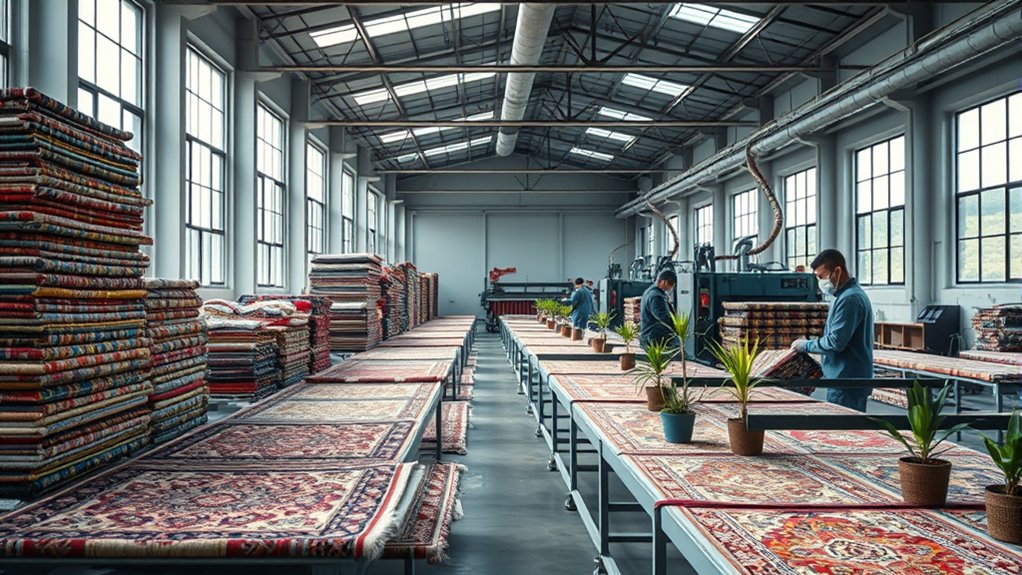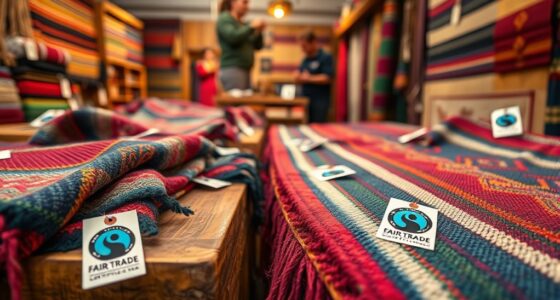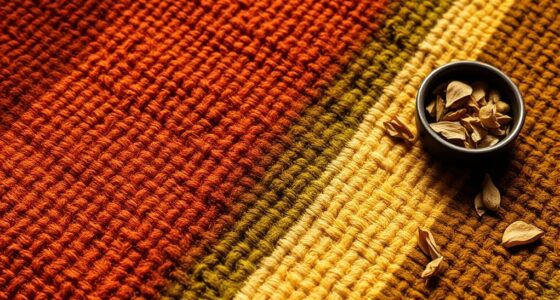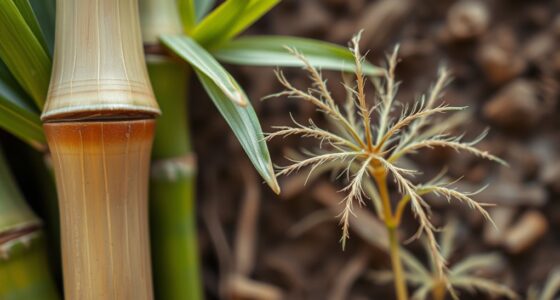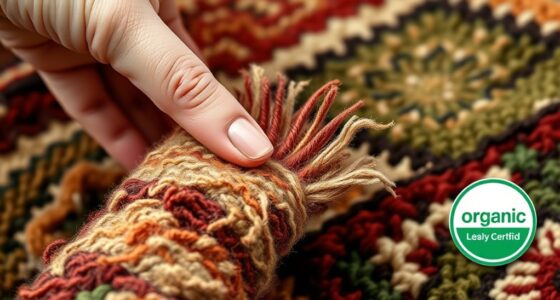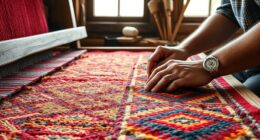To reduce the carbon footprint of rug manufacturing, choose products made from natural, biodegradable materials like wool, jute, or organic cotton, which need less energy to produce. Support brands that implement energy-efficient technologies and prioritize local sourcing to cut transportation emissions. By opting for eco-friendly materials and production practices, you can make a significant difference. Continuing to explore sustainable options will help you understand how your choices impact the environment even more.
Key Takeaways
- Using sustainable materials like wool, jute, and organic cotton reduces the carbon footprint of rug production.
- Implementing energy-efficient manufacturing technologies minimizes greenhouse gas emissions.
- Sourcing raw materials locally decreases transportation-related emissions and overall environmental impact.
- Supporting brands with transparent supply chains encourages eco-friendly practices and accountability.
- Consumer choices for eco-conscious rugs drive industry shifts toward more sustainable and low-impact manufacturing.
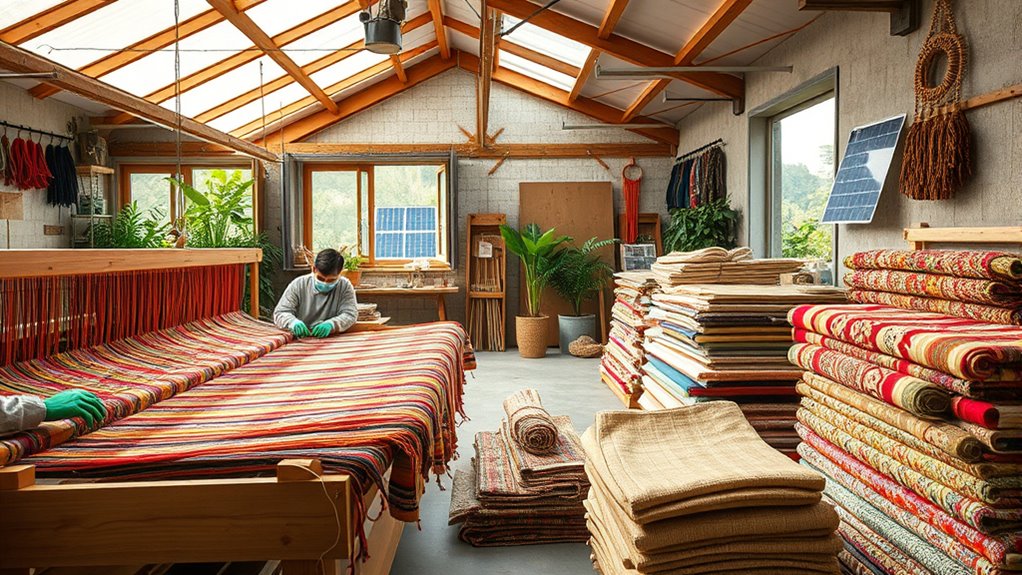
Rug manufacturing considerably contributes to carbon emissions, impacting the environment more than many people realize. Every step in creating a rug—from sourcing raw materials to the finishing touches—consumes energy and resources. But by understanding how this process affects the planet, you can make more sustainable choices and encourage manufacturers to adopt eco-friendly practices. One effective way to reduce the carbon footprint of rug manufacturing is by prioritizing the use of sustainable materials. Instead of traditional synthetic fibers, opt for natural options like wool, jute, or organic cotton, which are renewable and biodegradable. These materials often require less energy to produce and decompose more easily at the end of their life cycle, minimizing waste and pollution. When more manufacturers shift to sustainable materials, the overall environmental impact of rug production decreases considerably.
Choosing natural, biodegradable materials like wool, jute, or organic cotton reduces rug manufacturing’s environmental impact.
Energy efficiency also plays a crucial role in reducing the carbon footprint of rug manufacturing. Factories that implement energy-efficient technologies, such as LED lighting, advanced insulation, and energy-saving machinery, consume less power and emit fewer greenhouse gases. As a consumer, you can support brands that invest in these innovations, encouraging the industry to adopt greener practices. Additionally, energy-efficient processes often lead to cost savings, which can be passed down to consumers or reinvested into further sustainable improvements. By choosing rugs produced with energy-conscious methods, you’re not only opting for a stylish piece but also supporting a cleaner, greener manufacturing process. Recognizing the importance of carbon footprint reduction in manufacturing can inspire greater accountability and innovation within the industry.
It’s also worth considering the supply chain when evaluating a rug’s environmental impact. Shortening transportation distances by sourcing locally reduces fuel consumption and emissions. Manufacturers who prioritize local suppliers and eco-friendly logistics contribute less to global pollution. As a consumer, asking questions about where and how your rug was made can influence companies to adopt more sustainable practices throughout their supply chain.
Reducing the carbon footprint of rug manufacturing isn’t just about the end product; it’s about supporting a more responsible industry. Your choices—whether selecting rugs made from sustainable materials, supporting brands that prioritize energy efficiency, or advocating for transparent supply chains—can drive meaningful change. When you become conscious about these factors, you’re helping to lower greenhouse gas emissions associated with rug production. Over time, increased demand for eco-friendly rugs will push more manufacturers to innovate and adopt sustainable practices, creating a positive ripple effect. By making informed decisions, you’re playing an active role in fostering a healthier environment and encouraging sustainable growth within the industry.
Frequently Asked Questions
How Can Consumers Identify Eco-Friendly Rug Brands?
You can identify eco-friendly rug brands by looking for eco labels on their products, which indicate sustainable practices. Check their material sourcing to guarantee they use natural, recycled, or responsibly harvested fibers. Research brands that prioritize transparency about their supply chain and manufacturing processes. By paying attention to these details, you ensure you’re choosing rugs that minimize environmental impact and support sustainable practices.
What Are the Future Innovations in Sustainable Rug Manufacturing?
Imagine vibrant rugs crafted with sustainable fibers that shimmer with eco-conscious dyeing techniques, reducing environmental harm. Future innovations include advanced sustainable fiber development, creating durable, biodegradable materials. Eco-friendly dyeing techniques will minimize water and chemical use, making production cleaner. You’ll see smarter manufacturing processes, like automated, energy-efficient systems, reducing waste. These innovations will make eco-friendly rugs more accessible, helping you enjoy stylish, sustainable decor while caring for the planet.
How Does Transportation Impact the Overall Rug Carbon Footprint?
Transportation substantially impacts your rug’s overall carbon footprint through transport emissions and supply chain impact. When rugs are shipped over long distances or via inefficient modes, it increases greenhouse gases. You can reduce this impact by choosing local suppliers, optimizing shipping routes, and supporting companies that prioritize eco-friendly transport options. These steps help lower transport emissions, making your rug more sustainable and reducing its environmental footprint.
Are There Certifications for Eco-Friendly Rug Production?
Imagine walking into a room where your rug’s vibrant colors originate from natural dyes, and its fibers are recycled materials, glowing with eco-friendly pride. Yes, there are certifications like GOTS and OEKO-TEX that verify environmentally friendly practices. These labels guarantee your rug’s production minimizes harmful chemicals and waste, making it easier for you to choose sustainable options that protect the planet while adding beauty to your space.
What Are the Economic Benefits of Reducing Manufacturing Emissions?
Reducing manufacturing emissions saves you money through lower energy costs and improved efficiency. These cost savings boost your profitability and help you stay competitive in the market. Additionally, eco-friendly practices enhance your brand reputation, attracting environmentally conscious customers. By cutting emissions, you also reduce regulatory risks and potential fines. Overall, sustainable manufacturing not only benefits the environment but also strengthens your economic position and market competitiveness.
Conclusion
By choosing eco-friendly rugs and supporting sustainable practices, you gently steer the industry toward greener horizons. Every small step you take helps soften the environmental footprint of rug manufacturing, making a subtle yet meaningful difference. Remember, even modest changes can lead to a brighter, more sustainable future. Your mindful choices encourage manufacturers to embrace greener methods, quietly transforming the industry for the better. Together, we can tip the balance toward a more harmonious relationship with our planet.
